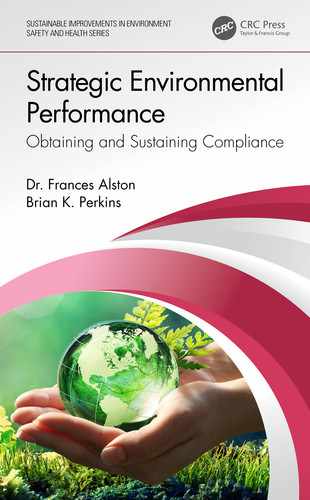Contents
Chapter 1 Environmental Compliance and the Corporate Structure
1.1 Defining the Compliance Profile
1.2 Alignment with the Mission of the Company
1.3 Organizational Structures That Enable Compliance
1.3.1 Functional Organization Structure
1.3.2 Divisional Organization Structure
1.3.3 Matrixed Organization Structure
1.3.4 Flat Organization Structure
2.2 Top-Down Leadership: Demonstrated Commitment
2.3 Employee Buy-In and Engagement
2.4 Cultural Impacts on Compliance
2.5 Evaluating Culture for Effectiveness
Chapter 3 Identifying Applicable Requirements
3.1 Environmental Regulations Overview
3.3.2 The Clean Water Act Today
3.3.2.4 Construction Storm Water
3.3.2.5 Industrial Storm Water
3.3.2.7 Concentrated Animal Feeding Operations
3.3.2.8 Spills of Oils and Hazardous Substances (SPCC)
3.3.2.11 Facility Response Plan
3.3.5 Resource Conservation and Recovery Act
3.3.5.3 Hazardous Waste Transporters
3.3.5.4 Treatment, Storage and Disposal Facilities (TSDFs)
3.3.5.5 Land Disposal Restrictions (LDRs)
3.3.5.7 Underground Storage Tanks
3.3.6 Emergency Planning and Community Right to Know Act (EPCRA)
3.3.7 Toxic Substances Control Act
3.3.8 Safe Drinking Water Act (SDWA)
3.3.9 National Environmental Policy Act
3.3.11 Federal Insecticide, Fungicide and Rodenticide Act
3.3.12 Comprehensive Environmental Response Compensation and Liability Act (CERCLA)
3.7 Regulatory Relationship Development and Sustainment
3.8 Other Directives and Corporate Policy
3.9 Establishing and Documenting Applicability
Chapter 4 Implementation Roles, Responsibilities and Accountability
4.1 Leadership Charting the Way
4.1.1 Leadership Style and Impact
4.1.2 Communicating the Importance of Environmental Compliance
4.2.1 Where Implementation Really Takes Place
4.2.2 Motivated versus Reluctant Implementation
4.3 Environmental Subject Matter Experts and Professionals
4.3.1 What Defines an Environmental Subject Matter Expert?
4.3.2 Training, Experience and Keeping Skills Relevant
4.3.3 Compliance Decision-Making
4.4 Removing Ambiguity from Compliance Decisions
Chapter 5 Flow Down of Requirements
5.1 Communicating Requirements within the Organization
5.2 Developing Processes for Requirements Flow Down
5.2.1 Corporate-Level Processes
5.2.2 Organization-Level Processes
5.2.3 Work Unit–Level Processes
Chapter 6 Requirements and Implementation Documents
6.1 Corporate-Level Procedures and Implementing Documents
6.2 Organization-Level Procedures and Implementing Documents
6.3.1 Development and Approval
6.3.2 Stakeholder Considerations
6.3.4 Configuration Management
6.3.5 Periodic Reviews and Updates
6.4 Accessibility of Procedures
Chapter 7 Critical Implementation Elements and Attributes
7.2 Training and Knowledge Retention
7.2.1 Appropriate Knowledge for Implementation
7.2.2 Training: A Necessary Investment for Success
Chapter 8 Requirements Tracking
8.1 Keeping Up with New Regulations
8.2 Tracking and Implementing Changes to Existing Regulations
8.3 Professional Working Groups Impacts and Participation
8.4 Conveying Legislative Changes
Chapter 9 Assessing and Measuring Program Performance
9.1 Defining Successful Performance for a Compliance Program
9.2 Effective Methods Used to Measure Performance
9.3 Identifying What Is Important: Corporate and Stakeholder Priorities
9.4 Evaluating Environmental Compliance Programs and Processes
9.5 Evaluating Implementation of Environmental Requirements
Chapter 10 Tracking and Trending Performance
10.1 Identifying and Use of Meaningful Metrics
10.1.1 How Well Are Regulatory Requirements Identified and Flowed Down
10.1.2 Meeting Regulatory Reporting Requirements
10.1.3 How Well Does the Program Promote Compliance and the Corporate Mission
10.2.1 Leading and Lagging Indicators
10.2.2 Purpose and Usefulness in Compliance Determination
10.2.3 How to Use Leading Indicators
10.2.3.1 Interrupting Leading Indicators
10.2.4 How to Use Lagging Indicators
10.2.4.1 Interrupting Lagging Indicators
10.3.1 Using Knowledge and Experience to Drive Improvements
10.3.2 The Propensity for Change to Facilitate Improvements
11.1 Learning from the Past to Prevent Future Occurrences
11.2 Capturing and Documenting Lessons Learned
11.3 Communicating Lessons Learned
11.4 Integrating Lessons Learned to Produce Change
Chapter 12 Compliance and Implementation Toolkit
Appendix A: Toolkit for Evaluating Resource Conservation and Recovery Act (RCRA)
Appendix B: Toolkit for Evaluating NPDES
Appendix C: Evaluating Air Emissions
Appendix D: Toolkit for Evaluating EPCRA
Appendix E: Toolkit for Evaluating SDWA
Appendix F: Toolkit for Evaluating SPCC
Appendix G: Toolkit for Evaluating FIFRA
Appendix H: Toolkit for Evaluating TSCA
Appendix I: Toolkit for Evaluating NEPA
